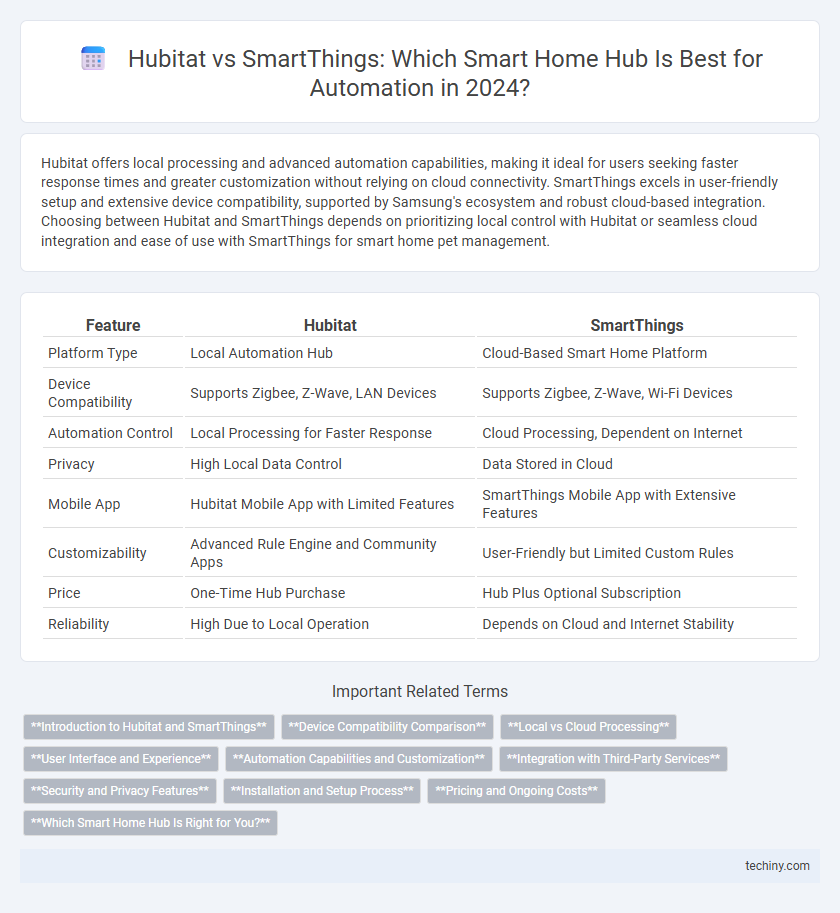Hubitat offers local processing and advanced automation capabilities, making it ideal for users seeking faster response times and greater customization without relying on cloud connectivity. SmartThings excels in user-friendly setup and extensive device compatibility, supported by Samsung's ecosystem and robust cloud-based integration. Choosing between Hubitat and SmartThings depends on prioritizing local control with Hubitat or seamless cloud integration and ease of use with SmartThings for smart home pet management.
Table of Comparison
| Feature | Hubitat | SmartThings |
|---|---|---|
| Platform Type | Local Automation Hub | Cloud-Based Smart Home Platform |
| Device Compatibility | Supports Zigbee, Z-Wave, LAN Devices | Supports Zigbee, Z-Wave, Wi-Fi Devices |
| Automation Control | Local Processing for Faster Response | Cloud Processing, Dependent on Internet |
| Privacy | High Local Data Control | Data Stored in Cloud |
| Mobile App | Hubitat Mobile App with Limited Features | SmartThings Mobile App with Extensive Features |
| Customizability | Advanced Rule Engine and Community Apps | User-Friendly but Limited Custom Rules |
| Price | One-Time Hub Purchase | Hub Plus Optional Subscription |
| Reliability | High Due to Local Operation | Depends on Cloud and Internet Stability |
Introduction to Hubitat and SmartThings
Hubitat and SmartThings serve as leading smart home hubs that enable centralized control of connected devices, offering robust automation capabilities and extensive compatibility. Hubitat provides local processing for faster response times and enhanced privacy, while SmartThings relies on cloud-based operations, delivering seamless integration with a wide range of smart home brands. Both platforms support Z-Wave, Zigbee, and Wi-Fi devices, but Hubitat appeals to users prioritizing local control and customization, whereas SmartThings excels in user-friendly cloud integration and mobile app accessibility.
Device Compatibility Comparison
Hubitat supports a wide range of Zigbee and Z-Wave devices with local processing, offering better privacy and faster response times for compatible smart home products compared to SmartThings. Samsung SmartThings excels in cloud-based integration, supporting a broader ecosystem of Wi-Fi, Zigbee, and Z-Wave devices, including seamless compatibility with popular brands like Philips Hue, Ring, and Nest. Both hubs provide robust device compatibility, but Hubitat prioritizes local automation while SmartThings emphasizes extensive third-party cloud service connections.
Local vs Cloud Processing
Hubitat offers local processing, ensuring faster response times and enhanced reliability by executing automations directly on the device without Internet dependency. SmartThings primarily relies on cloud processing, which allows seamless remote access and extensive integration but may experience latency or downtime due to server issues. Prioritizing local processing, Hubitat provides improved security and offline functionality, making it ideal for users who value privacy and immediate device control.
User Interface and Experience
Hubitat offers a highly customizable user interface tailored for advanced users who prefer detailed control and local automation without reliance on the cloud. SmartThings provides a more intuitive and polished app experience designed for ease of use, ideal for beginners and users seeking seamless integration across a wide range of smart devices. Both platforms support mobile app control, but Hubitat emphasizes functionality and flexibility, while SmartThings prioritizes simplicity and user-friendly design.
Automation Capabilities and Customization
Hubitat offers highly advanced automation capabilities with local processing, enabling faster response times and greater reliability without relying on cloud services. SmartThings provides a cloud-based platform with extensive third-party device compatibility but may experience latency and dependency on internet connectivity. Hubitat's Rule Machine allows in-depth customization of automation rules, appealing to tech-savvy users seeking granular control, whereas SmartThings prioritizes user-friendly automation templates suitable for beginners.
Integration with Third-Party Services
Hubitat supports numerous local integrations with devices and protocols, offering limited but reliable cloud-based third-party service connections mainly through community-developed apps. SmartThings provides extensive native cloud integration with popular third-party services such as Alexa, Google Assistant, and IFTTT, enabling seamless voice control and automation across a broader range of smart home products. For users prioritizing robust third-party integrations and ease of setup, SmartThings offers a more expansive ecosystem compared to Hubitat's emphasis on local control and customization.
Security and Privacy Features
Hubitat offers robust local processing, minimizing cloud dependency and enhancing data security by keeping sensitive information within the home network. SmartThings relies heavily on cloud-based services, which introduces potential vulnerabilities due to external server access and data transmission. Hubitat's emphasis on privacy aligns with users seeking greater control over their smart home data, while SmartThings prioritizes ease of use and broad device compatibility at the cost of increased privacy risks.
Installation and Setup Process
Hubitat offers a local processing hub with a straightforward installation process that emphasizes privacy and offline automation, requiring users to connect the device to their network and configure settings through a web interface. SmartThings provides a cloud-based platform with a user-friendly mobile app, enabling seamless integration with a wide range of smart devices but depends on internet connectivity for setup and operation. The Hubitat setup appeals to tech-savvy users prioritizing control and reliability, while SmartThings targets those seeking ease of use and extensive device compatibility.
Pricing and Ongoing Costs
Hubitat offers a one-time purchase price typically around $130 with no mandatory subscription fees, providing cost-effective long-term use for smart home automation. SmartThings requires an initial investment of approximately $70 for the hub but introduces ongoing subscription plans starting at $4.99 per month for advanced features and cloud services. Hubitat's local processing minimizes reliance on cloud services, reducing hidden costs, whereas SmartThings' cloud-dependency can lead to variable expenses over time.
Which Smart Home Hub Is Right for You?
Hubitat offers local processing for faster automation and enhanced privacy, making it ideal for users prioritizing reliability and offline capabilities. SmartThings provides a more user-friendly interface with extensive cloud-based integrations, appealing to those valuing ease of use and broad third-party compatibility. Choosing the right smart home hub depends on whether you prioritize local control and privacy (Hubitat) or seamless cloud connectivity and a larger ecosystem (SmartThings).
Hubitat vs SmartThings Infographic

 techiny.com
techiny.com